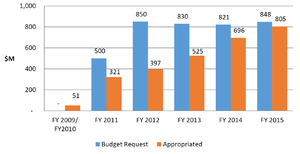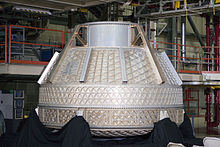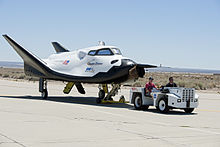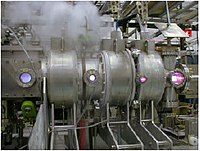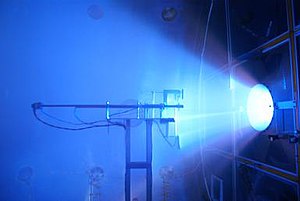First
group of nine astronauts selected for the NASA Commercial Crew
Development program and the two selected spacecraft, the Boeing CST-100 Starliner (left) and SpaceX Crew Dragon
NASA Commercial Crew and Cargo
| |
|---|---|
| Initiative | Period |
| Development | |
| Commercial Cargo Development | 2006–2013 |
| Commercial Space Transportation Capabilities | 2007–2010 |
| Commercial Crew Development (phase 1) | 2010–2011 |
| Commercial Crew Development (phase 2) | 2011–2012 |
| Commercial Crew integrated Capability (phase 3) (base period milestones) |
2012–2014 |
| Commercial Crew integrated Capability (phase 4) (optional period milestones) |
2014–2017 |
| Certification | |
| Certification Products Contract (crew) | 2012–2014 |
| Commercial Crew Transportation Capability | 2014–2017 |
| Services | |
| Commercial Resupply Services (cargo) | 2011–2016 |
| ISS Crew Transportation Services (crew) | 2017–present |
| NASA's COTS program Private spaceflight companies | |
Commercial Crew Development (CCDev) is a multiphase, space technology development program that is funded by the U.S. government and administered by NASA. The program is intended to stimulate development of privately operated crew vehicles to be launched into low Earth orbit. The program is run by NASA's Commercial Crew and Cargo Program Office (C3PO).
In 2010, in the first phase of the program, NASA provided $50
million combined to five American companies; the money was intended for
research and development into private-sector human spaceflight concepts
and technologies. NASA solicited a second set of CCdev proposals for
technology development projects lasting for a maximum of 14 months in
October of that year.
In April 2011, NASA announced they would award up to nearly $270
million to four companies as they met their CCDev 2 objectives.
NASA awarded Space Act Agreements for the third phase, named CCiCap, in August 2012; this would last until 2014. CCiCap is followed by CCtCap with Federal Acquisition Regulation (FAR) Part 15 contracts, which formed the fourth and final phase of the program. Contracts were awarded to SpaceX and Boeing in September 2014. Test flights of both spacecraft are scheduled for late 2018. SpaceX and Boeing have contracts with NASA to each supply six flights to ISS between 2019 and 2024. The first group of astronauts assigned to fly on the two selected spacecraft were announced on August 3, 2018.
Requirements
The key, high-level requirements for the Commercial Crew vehicles include:
- Deliver and return four crew members and their equipment to International Space Station (ISS);
- Provide assured crew return in the event of an emergency;
- Serve as a 24-hour safe haven in the event of an emergency;
- Capable of remaining docked for 210 days—the Space Shuttle could only remain docked for a maximum of 12 days.
Program overview
Flag left aboard ISS by the crew of STS-135 is to be retrieved by the next crew launched on an American vehicle.
The NASA CCDev program followed Commercial Orbital Transportation Services
(COTS), a program for developing commercial launch capability to send
cargo into low Earth orbit. In December 2009, NASA provided the
following description of the CCDev program:
The objectives of the Commercial Crew & Cargo Program are to implement U.S. Space Exploration policy with investments to stimulate the commercial space industry; facilitate U.S. private industry demonstration of cargo and crew space transportation capabilities with the goal of achieving safe, reliable, cost effective access to low-Earth orbit; and create a market environment in which commercial space transportation services are available to Government and private sector customers.
The Commercial Crew & Cargo Program is applying Recovery Act funds to stimulate efforts within the private sector to develop and demonstrate human spaceflight capabilities. NASA plans to use funds appropriated for "Exploration" under the American Recovery & Reinvestment Act of 2009 (ARRA) through its C3PO to support efforts within the private sector to develop system concepts and capabilities that could ultimately lead to the availability of commercial human spaceflight services. These efforts are intended to foster entrepreneurial activity leading to job growth in engineering, analysis, design, and research and to promote economic recovery as capabilities for new markets are created.
ARRA provided $400 million for space exploration related activities. Of this amount, $50 million is to be used for the development of commercial crew space transportation concepts and enabling capabilities. This effort is known as CCDev. The purpose of this activity is to provide funding to assist viable commercial entities in the development of system concepts, key technologies, and capabilities that could ultimately be used in commercial crew human space transportation systems. This development work must show, within the timeframe of the agreement, significant progress on long lead capabilities, technologies and commercial crew risk mitigation tasks in order to accelerate the development of their commercial crew space transportation concept.
Contract funding for the CCDev program is different from traditional space industry
contractor funding used on the Space Shuttle, Apollo, Gemini, and
Mercury programs. Contracts are explicitly designed to fund subsystem
technology development objectives that NASA wants for NASA purposes; all
other system technology development is funded by the commercial
contractor. Contracts are issued for fixed-price, pay-for-performance
milestones. "NASA's contribution is fixed".
Funding and effect on schedule
Requested vs appropriated funding by year
The first flight of the CCDev program was planned to occur in 2015, but insufficient funding caused delays. Administrator of NASA Charles Bolden attributed the delays to insufficient funding from Congress. Michael López-Alegría, President of the Commercial Spaceflight Federation, also attributed the delays in the program to funding problems.
For the fiscal year (FY) 2011 budget, US$500 million was
requested for the CCDev program, but Congress granted only $270 million.
For the FY 2012 budget, $850 million was requested but Congress
approved a budget of $406 million, and as a result the first flight of
CCDev was postponed from 2016 to 2017. For the 2013 budget, 830 million was requested but Congress approved $488 million. For the FY 2014 budget, $821 million was requested, Congress approved $696 million. In FY 2015, NASA received $805 million from Congress for the CCDev program; 95% of the $848 million requested by the Obama administration and the largest annual amount since the beginning of the program.
Spaceflight gap after STS
Saturn IB mounted on the "milkstool" platform. Its 1975 flight was the last manned U.S. mission until 1981
After the last flight of the STS in 2011 the clock began ticking on a U.S. spaceflight gap. The previous spaceflight gap was between 1975 (a Saturn IB launch) and the first STS flight in April 1981, about six years.
Unlike the last human spaceflight gap, the U.S. has bought seats on the
still-active Russian launcher as part of their continuing joint
international project, the International Space Station.
U.S. Congress was aware such a gap could occur and accelerated funding
in 2008 and 2009 in preparation for the retirement of the Shuttle. At that time the first crewed flight of the planned Ares I launcher would not have occurred until 2015, and its first use at ISS until 2016. Steps were also taken to extend STS operation past 2010. However, in 2010 the Ares I was cancelled and focus shifted to the Space Launch System and the commercial crew program. As of 2016 the first manned flight of SLS is Exploration Mission 2, to launch in 2021 at the earliest. As of 2016 a manned commercial crew mission might occur as early as 2018.
If NASA does get access to its own launcher it may be able to again
trade seats rather than buy them, or the two countries may organize
another sale. NASA has bought seats for 2018, and it may need to buy seats for 2019 also.
NASA bought seats on the Russian launcher even while the Space
Shuttle was active, and partners in the International Space Station
project needed to cross-train on each-others launchers and equipment.
When the STS program ended, this aspect of the involvement in ISS
continued, and NASA has a contract for seats until at least 2017. The price has varied over time, and the batch of seats from 2016 to 2017 works out to 70.7 million per passenger per flight.
The use of the Russian launcher Soyuz by NASA was a part of the ISS
program which was orchestrated in the 1990s when that project was
planned out: it is used as the emergency lifeboat for the station even
before the Space Shuttle retired so anyone staying on the station had to
train on this spacecraft regardless. The first Soyuz flight to ISS in 2000 included a U.S. astronaut (Soyuz TM-31 as part of Expedition 1).
U.S. astronauts regularly flew on the Soyuz while the Shuttle program
regularly visited the Station, even as it brought major components.
Likewise Russian and other international partners also flew on the Space
Shuttle and the Soyuz spacecraft, sometimes only on one direction of
the journey.
The U.S. was working on an emergency escape vehicle called the HL-20 Personnel Launch System
but was cancelled in 1993 in favor of using extra Soyuz spacecraft as
lifeboats; not developing another spacecraft was seen as a way to save
money in the aftermath of restructuring the Space Station Freedom
project when the USSR dissolved in 1991. Regardless, CCDev "seats" have often been compared to Soyuz prices for comparison during its development. With no other launcher available NASA may have to buy seats until 2019 to access the international space station. The other main partners in ISS, the ESA, cancelled its own manned launch system, the Hermes mini-shuttle, in 1992. The ESA had previously traded Spacelab hardware for flights on Space Shuttles. There has been some interest from Europe in the CCDev contenders, especially with Dream Chaser, with one party saying it was, "..ideal vehicle for a broad range of space applications."
Phases
CCDev 1
Construction of the CST-100 pressure vessel was one of Boeing's CCDev 1 milestones
Under CCDev phase 1, NASA has entered into funded Space Act Agreements with several companies working on technologies and systems for human space flight. Funding was provided as part of the American Recovery and Reinvestment Act of 2009.
A total of $50 million for 2010 was awarded to five American companies
with the intention of fostering research and development into human
spaceflight concepts and technologies in the private sector. The phase 1 amount was originally intended to be $150 million, most of which was diverted to the Constellation program by Senator Richard Shelby (R-AL). All 53 delivery milestones for the five companies were scheduled to be completed by the end of 2010.
Proposals selected
NASA awarded development funds to five companies under CCDev 1:
- Blue Origin: $3.7M for an innovative 'pusher' Launch Abort System (LAS) and composite pressure vessels. As of February 2011, with the end of the second ground test, Blue Origin has completed all work for the pusher escape system planned under the contract. It has also "completed work on the other aspect of its award, risk reduction work on a composite pressure vessel" for its vehicle.
- Boeing: $18M for development of the CST-100 capsule it demonstrated in October 2010. According to NASA's website all milestones were completed.
- Paragon Space Development Corporation: $1.4M for a plug-and-play environmental control and life support system (ECLSS) Air Revitalization System (ARS) Engineering Development Unit. With "the completion of testing in mid-December [2010] of its 'Commercial Crew Transport Air Revitalization System', a life support system intended for use on [multiple different] commercial crew vehicles", Paragon has completed all work under the contract.
- Sierra Nevada Corporation: $20M for development of the Dream Chaser, a reusable spaceplane vehicle that can transport cargo and up to eight people to low Earth orbit. Sierra Nevada completed its work under the contract in December 2010, with the structural testing of its engineering test article—its fourth and final milestone.
- United Launch Alliance: $6.7M for an Emergency Detection System (EDS) for human-rating its Evolved Expendable Launch Vehicles (EELVs). In December 2010, ULA carried out a demonstration of its Emergency Detection System; according to NASA's website all milestones were completed.
Proposals received
During the evaluation phase of CCDev1 proposals were received from the following participants:
CCDev 2
The construction of a Dragon crew mock-up was one of SpaceX's CCDev 2 milestones, it is seen here during an event
NASA sought a second set of Commercial Crew Development proposals in
October 2010. These could be both new concepts and proposals that mature
the design and development of system elements, such as launch vehicles
and spacecraft. NASA originally planned to issue about $200 million of
Space Act Agreements in March 2011.
On April 18, 2011, NASA awarded nearly $270 million to four companies
for developing U.S. vehicles that could fly astronauts after the Space
Shuttle fleet's retirement.
In August the same year, NASA provided status on the progress
milestones of the four companies developing crew vehicle technologies
under CCDev 2.
There are nine-to-eleven specific milestones, spread over the second
quarter of 2011 through to the second quarter of 2012, that each company
must meet to receive their performance-based funding for CCDev 2.
Proposals selected
Winners of funding in the second round of the CCDev were:
- Blue Origin, Kent, Washington: $22 million. Blue Origin proposed advancing technologies in support of a biconic nose cone design orbital vehicle, including launch abort systems and restartable, liquid oxygen/liquid hydrogen engines. Blue Origin has since completed all of its CCDev 2 milestones. In November 2014, NASA announced three additional unfunded milestones, which include further testing of Blue Origin's propellant tank, BE-3 engine and pusher escape system.
- Sierra Nevada Corporation, Louisville, Colorado: $80 million. Sierra Nevada proposed four phase 2 extensions of its Dream Chaser spaceplane technology. Like the Orbital Sciences proposal, the Dream Chaser was also a lifting body design. Sierra Nevada will use Virgin Galactic to market Dream Chaser commercial services and will use Virgin's WhiteKnightTwo carrier aircraft as a platform for drop trials of the Dream Chaser atmospheric test vehicle in 2012.
- Space Exploration Technologies (SpaceX), Hawthorne, California: $75 million. SpaceX proposed to develop an "integrated launch abort system design" for the Dragon spacecraft, with theoretical advantages over the more traditional tractor tower approaches used on earlier manned space capsules. The system would be part of SpaceX's Draco maneuvering system, which is currently used on the Dragon capsule for in-orbit maneuvering and de-orbit burns. SpaceX completed its CCDev 2 milestones by August 2012.
- The Boeing Company, Houston, Texas: $92.3 million. Boeing proposed additional development for the seven-person CST-100 spacecraft, beyond the objectives for the $18 million received from NASA in CCDev 1. The capsule will have personnel and cargo configurations, and is designed to be launched by multiple different rockets and be reusable up to 10 times.
Proposals selected without NASA funding
- United Launch Alliance proposed to extend development work on human-rating the Atlas V rocket. Although not selected for funding, NASA entered into an unfunded Space Act Agreement with ULA in July 2011 to share information with the goal of advancing the development of the rocket, which is the proposed launch vehicle for the Blue Origin, Boeing and Sierra Nevada Corporation proposals. ULA finished completing all of their CCDev 2 milestones by September 2012.
- Alliant Techsystems (ATK) and Astrium proposed development of the Liberty rocket derived from the Ares I and Ariane 5. On September 13, 2011, it was reported that NASA intended to form at agreement with ATK to further develop the Liberty rocket as a heavy launch vehicle capable of launching humans into space. Although no funding is to be provided by NASA, the agency will share expertise and technology. ATK finished completing all of its CCDev 2 milestones by August 2012.
- Excalibur Almaz Inc. is developing a crewed system incorporating modernized, Soviet-era space hardware designs intended for tourism flights to orbit. On October 26, 2011, NASA announced it had entered into an unfunded Space Act Agreement with EAI, establishing a framework to collaborate to further develop EAI's spacecraft concept for low Earth orbit crew transportation. EAI's concept for commercial crew to the ISS is to use the company's planned three-person space vehicle with an intermediate stage and fly the integrated vehicle on a commercially available launch vehicle. Excalibur Almaz finished completing all of their CCDev 2 milestones by June 2012.
Proposals not selected
Proposals that were not awarded funds in the second round of the CCDev program were:
- Orbital Sciences proposed the Prometheus lifting-body spaceplane vehicle, about one-quarter the size of the Space Shuttle. The Vertical Takeoff, Horizontal Landing (VTHL) vehicle would be launched on a human-rated Atlas V rocket but would land on a runway. The initial design would carry a crew of four, but it could carry up to six people or a combination of crew and cargo. In addition to Orbital Sciences, the consortium included Northrop Grumman that would have built the spaceplane and the United Launch Alliance that would have provided the launch vehicle. Virgin Galactic also confirmed it would be teaming with Orbital on the Orbital CCDev 2 project. After failing to be selected for a CCDev phase 2 award by NASA, Orbital announced in April 2011 it would likely wind down its efforts to develop a commercial crew vehicle.
- Paragon Space Development Corporation proposed additional development of the Commercial Crew Transport-Air Revitalization System (CCT-ARS) program in 2011, to permit the building-out of the other parts of the Environmental Control and Life Support Systems to provide the complete solution for its commercial crew transport customers.
- t/Space proposed a recoverable, reusable, eight-person crew or cargo transfer spacecraft that could launch on a variety of launch vehicles including the Atlas V, Falcon 9 and Taurus II rockets.
- United Space Alliance proposed under a plan called Commercial Space Transportation Service (CSTS) to fly commercially the two remaining Space Shuttle vehicles, Endeavour and Atlantis, twice a year from 2013 to 2017.
Commercial Crew integrated Capability
Flight testing of the Dream Chaser Engineering Test Article was one of Sierra Nevada's CCiCap milestones
The Commercial Crew integrated Capability (CCiCap) initiative is the
third round of the CCdev program and was originally called CCDev 3.
For this phase of the program, NASA wanted proposals to be complete,
end-to-end designs including spacecraft, launch vehicles, launch
services, ground and mission operations, and recovery. In September
2011, NASA released a draft request for proposals (RFP).
The U.S. government's was originally intended to use a new
contracting mechanism for CCiCap that differed from the Space Act
Agreement's fixed-price, milestone-based contracts of the previous
phases. As of October 2011, NASA was planning to award competitive contracts under the more traditional Federal Acquisition Regulations (FAR) system instead of using Space Act Agreements.
After some months of planning for the new-style contracting approach,
NASA announced in mid-December 2011 it would resume use of Space Act
Agreements because of Congressional funding reductions to the program
for Fiscal Year 2012. NASA planned to use FAR contracts for the certification of Commercial Transportation Services to the ISS. The final RFP was released on February 7, 2012, with proposals due on March 23, 2012.
The funded Space Act Agreements were awarded on August 3, 2012,
and amended on August 15, 2013. CCiCap contracts were planned to be
completed by August 2014.
NASA hoped facilitating development of this U.S. capability will
provide safe, reliable and cost effective human transportation to
low-Earth orbit (LEO).
Proposals selected
Winners of funding in the third round of the Commercial Crew Development program, announced on August 3, 2012, were:
- Sierra Nevada Corporation, Louisville, Colorado: $212.5 million. Sierra Nevada Corporation proposed further development of its Dream Chaser spaceplane/Atlas V system.
- Space Exploration Technologies (SpaceX), Hawthorne, California: $440 million. SpaceX proposed further development of the Dragon spacecraft / Falcon 9 system.
- The Boeing Company, Houston, Texas: $460 million. Boeing proposed further development for the CST-100 spacecraft/Atlas V system.
Proposals that passed acceptability screening
- ATK – Liberty
Proposals not selected
Development achievements
NASA reported that as of November 2014, Boeing had completed its CCiCap milestones;
Sierra Nevada had completed 10 of its 13 milestones; SpaceX had
completed 13 of its 18 milestones. SpaceX received an extra milestone
that is to be completed by March 2015. The milestones are listed in the appendixes to the Funded Space Act Agreements.
In May 2014, Boeing, Sierra Nevada Corporation and SpaceX completed
reviews detailing plans to meet NASA's certification requirements to
transport crew members to and from the ISS.
Preparation for the next phase
In
June 2014, Boeing announced it intended to send out preliminary lay-off
notices to 215 employees—approximately 170 in Houston and 45 in
Florida—to prepare for the possibility that Boeing would not be selected
to continue work into the next phase following the expected NASA
shortlist in mid-2014. These advance notices are required under the Worker Adjustment and Retraining Notification Act
(WARN) legislation under U.S. law, and must be issued 60 days before
any large lay-off is expected to take effect. If Boeing was selected to
continue, the lay-offs would not occur and Boeing would hire an
additional 75 personnel. Sierra Nevada "is not preparing any WARN
notices to its Dream Chaser workforce".
Certification Products Contract (CPC) phase 1
The
first phase of the Certification Products Contract (CPC) involved the
review of the integrated crew transportation systems through the
creation of a certification plan that would result in the development of
engineering standards, tests and analyses of the systems' designs. This phase of CPC was expected to run from January 22, 2013, to May 30, 2014.
Proposals selected
Winners of funding of phase 1 of the CPC, announced on December 10, 2012, were:
- Sierra Nevada Corporation, Louisville, Colorado: $10 million.
- Space Exploration Technologies (SpaceX), Hawthorne, California: $9.6 million.
- The Boeing Company, Houston, Texas: $9.9 million.
Certification Products Contract (CPC) phase 2
The
second phase of the CPC was expected to begin in mid-2014; it would
involve a full and open competition and would include the final
development, testing and verifications to allow crewed demonstration
flights to the ISS. Phase 2 is called Commercial Crew Transportation Capability (CCtCap).
NASA proposed the second phase of the program would begin purchasing
commercial astronaut transportation services with the CCtCap
solicitation. Contract award and funding occurred in 2014; flights of
NASA astronauts on CCtCap-provided vehicles would not occur before 2017.
In a change from previous CCDev programs where commercial providers
tested the developed technology to NASA contractual requirements, CCtCap
will include Joint Test Teams (JTT) with NASA personnel operating in a
traditional NASA acquisition approach in which NASA oversees some design
choices and offers flexible-price cost-sharing to pay for the tests. NASA issued the draft CCtCap contract's Request For Proposals (RFP) on July 19, 2013; the response date was August 15, 2013.
According to the letter and Executive Summary:
- "The [CCtCap] contract is the second phase of a 2-phased procurement strategy to develop a U.S. commercial crew space transportation capability to achieve safe, reliable and cost effective access to and from the [ISS] with a goal of no later than 2017".
- Performance-based payments are to be used in this competitive, negotiated acquisition.
- Proposed deviation language to specific FAR and NFS clauses and proposed waiving of clauses were suggested.
- Under CCtCap the final Design, Development, Test, and Evaluation (DDTE) activities necessary to achieve NASA's certification of a Crew Transportation System (CTS) will be conducted. The contract will be issued under Federal Acquisition Regulations (FAR) Part 15 and will be Firm Fixed Price (FFP).
There are four separate Contract Line Items (CLINs) for CTS
certification; ISS mission support, special studies and additional cargo
capability if proposed.
NASA was to supply four Docking System Block 1 Units on a
no-charge-for-use basis. The first unit would be available in February
2016.
NASA held a Commercial Crew Pre-proposal Conference at Kennedy Space
Center on December 4, 2013, after formally requesting proposals for
CCtCap in late November that year.
NASA's 2014 budget for CCtCap was US$696 million; it was reduced from an Obama Administration request of US$821 million.
In May 2014, NASA announced each awardee was to perform at least one
crewed test flight to verify the spacecraft could dock with the ISS and
all its systems performed as expected. NASA intended to meet its station
crew rotation requirements by including at least two, and at most six
crewed, post-certification missions in the contracts. NASA also intended CCtCap would allow U.S. providers to supply other customers.
Awards
On
September 16, 2014, NASA announced that Boeing and SpaceX had received
contracts to provide crewed launch services to the ISS. For completing
the same contract requirements, Boeing could receive up to US$4.2
billion, while SpaceX could receive up to US$2.6 billion. Both Boeing CST-100 flying on United Launch Alliance (ULA) Atlas V and SpaceX Dragon V2 flying on Falcon 9
were awarded for the same set of requirements: completing development
and certification of their crew vehicle then flying a certification
flight followed by up to six operational flights to the ISS. The
contracts included at least two operational flights for each company.
The total program award of US$6.8 billion covers development
costs through CCtCap program funding—$3.42 billion over the years
2015–2019 with $848 million in the commercial crew budget request for FY
2015—and $3.4 billion for operational crew resupply to the ISS—12
flights with four astronauts on each flight, where NASA assumed the same
per-seat price of $70.7 million it would pay for each Soyuz seat in
2016.
With the program awards in September, NASA did not release the number
of proposals it received or any details about the selection process; it
stated such information would be released "at an 'appropriate' but
unspecified date".
On September 26, 2014, Sierra Nevada Corporation submitted a
protest of the CCtCap awards, stating to have undercut Boeing by $900
million while scoring close to its competitors in the other criteria. The Government Accountability Office (GAO) had until January 5, 2015, to rule on the protest. By October 1, 2014, NASA had instructed Boeing and SpaceX to halt work on the CCtCap contracts. On October 8, 2014, NASA instructed the contractors to proceed with contract work during the GAO review. In January 2015, the GAO denied Sierra Nevada Corporation's protest.
In 2016 the firms scheduled additional testing and certification
milestones. The auditors do not expect the first flights until late
2018.
CCtCap contract progress
As of December 2014, both SpaceX and Boeing had started work on their Commercial Crew Transportation Capability (CCtCap) contracts.
As of September 2016 although both companies are advancing they
are running behind their previous schedule. Additional milestones have
been agreed with NASA see Annex B (Boeing) and Annex C (SpaceX) of the
September 2016 Audit of the Commercial Crew Program. Boeing increased its milestones from 23 to 34 and has achieved 15.
SpaceX has increased its milestones from 18 to 21 and has achieved 8.
SpaceX also has an uncompleted milestone left over from CCiCap.
Flights
As of January 2017 NASA has ordered twelve commercial
post-certification missions to deliver astronauts to the International
Space Station, six with each supplier. Astronaut selections for the first four missions were announced on August 2, 2018.
| Spacecraft | Mission | Description | Crew | Date |
|---|---|---|---|---|
| Dragon 2 | SpX-DM1 | Uncrewed test flight | None | January 2019 |
| CST-100 | Boe-OFT | Uncrewed test flight | None | March 2019 |
| Dragon 2 |
|
In-flight abort test at max Q | None | May 2019 |
| Dragon 2 | SpX-DM2 | Crewed test flight | Robert Behnken, Douglas Hurley | June 2019 |
| CST-100 | Boe-CFT | Crewed test flight | Eric Boe, Christopher Ferguson, Nicole Aunapu Mann | August 2019 |
| Dragon 2 | Crew-1 | First Dragon mission to ISS | Victor J. Glover, Michael S. Hopkins | September 2019 |
| CST-100 | CTS-1 | First Starliner mission to ISS | Josh Cassada, Sunita Williams | February 2020 |
Funding summary
The
funding of all commercial crew contractors for each phase of the CCP
program is as follows—CCtCap values are maxima and include
post-development operational flights.
| Round (years) |
CCDev1 (2010–2011) |
CCDev2(2011–2012) | CCiCap (2012–2014) |
CPC1 (2013–2014) |
CCtCap | Total (2010–2017) |
|---|---|---|---|---|---|---|
| Manufacturers of spacecraft | ||||||
| The Boeing Company | 18.0 | 92.3 + 20.61 | 460.0 + 203 | 9.9 | 4,200.0 | 4,820.9 |
| Blue Origin | 3.7 | 22.0 | – | – | – | 25.7 |
| Sierra Nevada Corporation | 20.0 | 80.0 + 25.61 | 212.5 + 153 | 10.0 | – | 362.1 |
| SpaceX | – | 75.0 | 440.0 + 203 | 9.6 | 2,600.0 | 3,144.6 |
| Excalibur Almaz | – | 02 | – | – | – | 0 |
| Manufacturers of launch vehicles | ||||||
| United Launch Alliance | 6.7 | 0 | – | – | – | 6.7 |
| Alliant Techsystems (ATK) | – | 0 | – | – | – | 0 |
| Others | ||||||
| Paragon Space Development Corporation | 1.4 | – | – | – | – | 1.4 |
| Total: | 49.8 | 315.5 | 1,167.5 | 29.6 | 6,800.0 | 8,362.4 |
| 1 Additional amount awarded in 2011. 2 Space Act Agreement signed in 2011 in the frame of CCDev2. 3 Additional amount awarded in 2013. | ||||||



